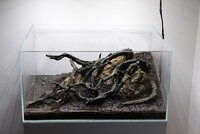Hey Darrel, sorry to break up the tomato party between you and foxfish but I have some news regarding my tank!
🙂 lol (Just kidding guys - I feel honoured that two of the most respected UKAPS members are posting so much in my journal).
🙂
So today I actually managed to get some planting done! It's so exciting for me; the first time I've touched an aquarium plant since May last year.
It's also my first ever attempt at attaching mosses using the 'blender' method. Here's what I did...
1. Put the moss into a plastic jug. Here I am using a mix of Riccardia chamedryfolia and Fissidens fontanus with a 4:1 ratio of Riccardia to Fissidens. I have decided not to use weeping moss at the moment. The idea between mixing the species is to hopefully create a more natural effect as the different textures merge.
2. Add a blob of greek yoghurt to about 100ml of RO water and mix.
3. Add the yoghurt solution to the plastic jug.
4. I used a hand-held blender to chop up the Riccardia/Fissidens.
5. The result is a green liquid containing millions of tiny pieces of moss.
 moss paste
moss paste by
George Farmer, on Flickr
6. I use a paintbrush to attach the moss to the wood and rocks.
 moss brush
moss brush by
George Farmer, on Flickr
The result looks quite effective, I think.
 moss closeup
moss closeup by
George Farmer, on Flickr
 moss close2
moss close2 by
George Farmer, on Flickr
 moss complete
moss complete by
George Farmer, on Flickr
The tank is covered with polythene (awaiting a custom-built cover glass) and have set my heating mat so there's a relatively constant 21C air temperature inside. The soil is slightly warmer. Room temperature is 18-20C.
The photoperiod has been set to 14hrs, with 2hrs ramping up and down at end of the period, so 10hrs at max intensity (<=80 PAR).
I will leave the tank covered for the first week.
Then I will fit my cover glass so a small air gap can encourage some gas exchange, as recommended by Mr Barr.
I happened to find a bottle of "Do!Aqua Be Bright" in my garage so am considering using this to spray the plants.
be Bright, do!aqua liquid additive for growing plants emersed
Tomorrow I plant the remaining plants (mainly hairgrass and some stems).












